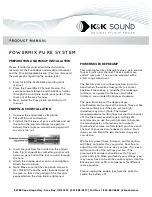
Figure 4.3.2
: Typical calibration curve measuring ppm.
Customers working in medical environments are quite likely to be using the S.I. unit of mmol/l to report their
results. The relationship between mmol/l and ppm is defined below:
Sodium
Na
1ppm = 0.0435mmol/l
1mmol/l = 23ppm
Potassium
K
1ppm = 0.0256mmol/l
1mmol/l = 39ppm
Lithium
Li
1ppm = 0.1441mmol/l
1mmol/l = 7ppm
Calcium
Ca
1ppm = 0.0250mmol/l
1mmol/l = 40ppm
This relationship means that Na and K samples in the normal clinical range of 136-145mmol/l Na and 3.5-
5.0mmol/l K should be pre-diluted 1 in 100 or 1 in 200 to get optimum results from the flame photometer.
Aspirate a blank solution and set the readout to 000 using the
blank
control.
Aspirate the highest standard solution and set the readout to an appropriate reading using the
fine
and
coarse
sensitivity controls. Re-check the blank setting and adjust if necessary.
Aspirate the remaining standard solutions (if used) to construct the calibration curve and note the
results.
When the blank and standards are set, unknown samples can be aspirated and the results
noted directly from the instrument readout.
Calibration needs to be checked periodically by aspirating the blank and standard solutions.
Initially this check should be carried out after every 10 samples. Experience and increased
confidence in the PFP7 will enable you to best judge the frequency of this check.
The decimal point (
d.p.
) switch can be set to illuminate the decimal point in any significant
position. This should be chosen to give sufficient resolution for the test required.
0
5
5
10
10
15
15
20
20
25
25
ppm
R
e
a
d
o
u
t
Unknown sample
reads 20 and can
be seen to have a
concentration of
approx. 16.5ppm
Calibration points
at 5,10,15,20 and
25ppm
0
5
5
10
10
15
15
20
20
25
25
ppm
R
e
a
d
o
u
t
0
5
5
10
10
15
15
20
20
25
25
ppm
R
e
a
d
o
u
t
Unknown sample
reads 20 and can
be seen to have a
concentration of
approx. 16.5ppm
Calibration points
at 5,10,15,20 and
25ppm
500 795/Rev E/03-17
Page 3












































